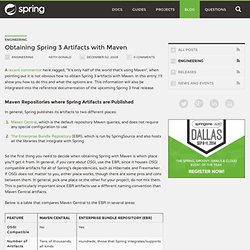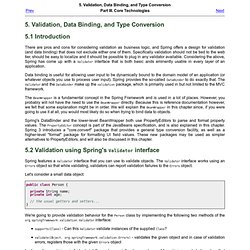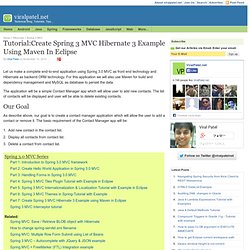

Obtaining Spring 3 Artifacts with Maven. A recent commentor here ragged, "It's only half of the world that's using Maven", when pointing out it is not obvious how to obtain Spring 3 artifacts with Maven.

In this entry, I'll show you how to do this and what the options are. This information will also be integrated into the reference documentation of the upcoming Spring 3 final release. Maven Repositories where Spring Artifacts are Published In general, Spring publishes its artifacts to two different places: Maven Central, which is the default repository Maven queries, and does not require any special configuration to use The Enterprise Bundle Repository (EBR), which is run by SpringSource and also hosts all the libraries that integrate with Spring So the first thing you need to decide when obtaining Spring with Maven is which place you'll get it from.
Below is a table that compares Maven Central to the EBR in several areas: Now that you know the options, I'll discuss how to obtain Spring artifacts from both places. <! <! Summary. Java - Spring @Transactional Annotation Best Practice. Java - Spring form without commandName. Need help with undestand ModelAndView in java spring.
5. Validation, Data Binding, and Type Conversion. 5.

Validation, Data Binding, and Type Conversion There are pros and cons for considering validation as business logic, and Spring offers a design for validation (and data binding) that does not exclude either one of them. Specifically validation should not be tied to the web tier, should be easy to localize and it should be possible to plug in any validator available. Considering the above, Spring has come up with a Validator interface that is both basic ands eminently usable in every layer of an application. Data binding is useful for allowing user input to be dynamically bound to the domain model of an application (or whatever objects you use to process user input).
The BeanWrapper is a fundamental concept in the Spring Framework and is used in a lot of places. Spring's DataBinder and the lower-level BeanWrapper both use PropertyEditors to parse and format property values. 5.2 Validation using Spring's Validator interface Let's consider a small data object: Table 5.1. Table 5.2. Tutorial:Create Spring 3 MVC Hibernate 3 Example using Maven in Eclipse. Let us make a complete end-to-end application using Spring 3.0 MVC as front end technology and Hibernate as backend ORM technology.

For this application we will also use Maven for build and dependency management and MySQL as database to persist the data. The application will be a simple Contact Manager app which will allow user to add new contacts. The list of contacts will be displayed and user will be able to delete existing contacts. Our Goal As describe above, our goal is to create a contact manager application which will allow the user to add a contact or remove it. Add new contact in the contact list.Display all contacts from contact list.Delete a contact from contact list. Following is the screenshot of end application.
Application Architecture We will have a layered architecture for our demo application. Getting Started For our Contact Manager example, we will use MySQL database. Creating Project in Eclipse Download the below source code: Maven Dynamic Web Project (6.7 KB) Inversion of Control Containers and the Dependency Injection pattern. In the Java community there's been a rush of lightweight containers that help to assemble components from different projects into a cohesive application.

Underlying these containers is a common pattern to how they perform the wiring, a concept they refer under the very generic name of "Inversion of Control". In this article I dig into how this pattern works, under the more specific name of "Dependency Injection", and contrast it with the Service Locator alternative. The choice between them is less important than the principle of separating configuration from use. One of the entertaining things about the enterprise Java world is the huge amount of activity in building alternatives to the mainstream J2EE technologies, much of it happening in open source. A lot of this is a reaction to the heavyweight complexity in the mainstream J2EE world, but much of it is also exploring alternatives and coming up with creative ideas.
Components and Services A Naive Example class MovieLister...